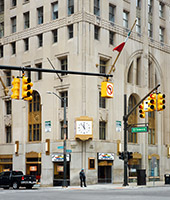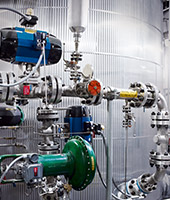Comparing Actual with Forecast Performance
During the year, WACKER specified and revised the targets originally set at the start of the year. The revisions affected the statements made regarding the sales trend, the EBITDA margin, ROCE, net cash flow, investment spending, depreciation and net financial debt. WACKER crossed the five-billion-euro sales threshold for the first time thanks to higher volumes and positive exchange-rate effects. Sales increased by 9.7 percent and were thus within the range we indicated when we published the Q1 Interim Report. The EBITDA margin was slightly lower than in 2014, as was forecast in the Q2 Interim Report. After adjustment for special income, EBITDA was substantially higher year over year, and thus better than we had forecast. In 2015, we again retained advance payments and received damages due to the termination of long-term polysilicon supply contracts, but the amounts involved were below the prior-year level. At WACKER POLYSILICON, solar-silicon prices decreased during the year. At Siltronic, volumes were slightly higher than in the prior year, prices were substantially lower in US dollar terms, and positive exchange-rate effects more than compensated for lower wafer prices. However, currency-hedging losses dampened earnings. Overall, Siltronic EBITDA was slightly higher year over year. As expected, the business trend was positive at our three chemical divisions – WACKER SILICONES, WACKER POLYMERS and WACKER BIOSOLUTIONS – due to a substantial rise in volumes and positive exchange-rate effects. On the whole, all three divisions increased their sales markedly. EBITDA was also substantially above the prior-year figure. Energy and raw-material cost trends varied. Raw-material costs came in somewhat higher; energy costs were within budget. The exchange rates of the US dollar and the yen against the euro developed as expected.
Sales Projections Raised after First Quarter
With the publication of the Q1 Interim Report in April 2015, WACKER raised its forecast for sales. Instead of a high-single-digit percentage increase, WACKER was now assuming that sales would rise by around 10 percent. Projections for ROCE were adjusted from lower to somewhat lower year over year. In the Q2 Interim Report in July 2015, the forecast for the EBITDA margin was revised. Instead of being substantially lower, the EBITDA margin was now expected to be only somewhat lower than in the previous year. Group sales in 2015 came in at € 5.30 billion. WACKER EBITDA amounted to € 1,048.8 million in the reporting year and, as expected, was on a par with the year before (2014: € 1,042.3). Due to the termination of polysilicon supply contracts, we posted € 137.6 million in income from advance payments retained and damages received. Our EBITDA for 2015 includes this income. Without this special income, EBITDA amounted to € 911.2 million (2014: € 836.0 million) and was thus substantially higher than in the previous year.
We increased investments during the year. Having originally estimated investments at around € 700 million, we raised that projection to some € 725 million in the Q1 forecast, then to about € 775 million in Q2 and finally to about € 800 million in Q3. At € 834.0 million, investments ultimately came in somewhat higher than the forecast published in our Q3 Interim Report. The largest share of this sum went toward the ongoing expansion of our polysilicon production facilities. The main reasons for this were higher assembly costs and exchange-rate effects.
Comparing Actual with Forecast Performance
| Download XLS |
|
|
|||||||||
|
Results in 2014 |
Forecast March 2015 |
Forecast Aug. 2015 |
Forecast Oct. 2015 |
Results in 2015 |
|||||
|
|
|
|
|
|
|||||
Key Financial Performance Indicators |
|
|
|
|
|
|||||
EBITDA margin (%) |
21.6 |
Substantially lower |
Somewhat lower |
Somewhat lower |
19.8 |
|||||
ROCE (%) |
8.4 |
Lower |
Somewhat lower |
Somewhat lower |
8.1 |
|||||
EBITDA (€ million) |
1,042.3 |
Slight rise when adjusted for special income |
Slight rise when adjusted for special income |
Slight rise when adjusted for special income |
1,048.8 |
|||||
Net cash flow (€ million) |
215.7 |
Slightly positive, but substantially lower than in 2014 |
Slightly positive |
Slightly positive |
22.5 |
|||||
|
|
|
|
|
|
|||||
Supplementary Financial Performance Indicators |
|
|
|
|
|
|||||
Sales (€ million) |
4,826.4 |
High-single-digit % increase |
Increase of about 10%, over 5 billion |
Increase of about 10%, over 5 billion |
5,296.2 |
|||||
Investments (€ million) |
572.2 |
Approx. 700 |
Approx. 775 |
Approx. 800 |
834.0 |
|||||
Net financial debt (€ million) |
1,080.6 |
Increase of between 200 and 300 |
At the prior-year level |
At the prior-year level |
1,074.0 |
|||||
Depreciation (€ million) |
599.0 |
Approx. 625 |
Approx. 625 |
Approx. 600 |
575.4 |
|||||
|
|
|
|
|
|
|||||
Net financial debt developed more favorably than had been expected at the beginning of the year. In March 2015, we had forecast that net financial debt would climb by between € 200 million and € 300 million by the end of the year. We subsequently assumed in the Q2 Interim Report that it would remain roughly at the prior-year level. Net financial debt was actually at this level at year-end, and amounted to € 1,074.0 million. The reduction in net financial debt was mainly due to the proceeds from the Siltronic AG IPO. As expected, net cash flow was slightly positive.
R & D expenditures for the development of future products and solutions amounted to € 175.3 million for full-year 2015, slightly lower than the figure forecast at the beginning of the year. This was due to more prudent management of resources, which meant the budget was not fully spent.
As anticipated at the start of the year, the workforce increased. As of the reporting date, WACKER had 16,972 employees, an increase from a year earlier.
The Executive and Supervisory Boards will propose a dividend of € 2.00 per share for 2015 (dividend for 2014: € 1.50) at this year’s Annual Shareholders’ Meeting.
Deviations from Projected Expenses
Personnel costs increased year over year in absolute terms. As a percentage of sales, however, these expenses were lower, which was basically in line with our target. A higher number of employees during the year under review was the primary reason for the increase in personnel costs. In addition, personnel expenses at our subsidiaries in the US dollar area rose due to the change in the dollar-euro exchange rate. Personnel expenses as a percentage of sales improved year over year as a result of our initiatives to improve productivity and optimize costs. In the mid-term, we expect personnel expenses as a percentage of sales to decrease slightly thanks to additional productivity measures.
Raw-material costs increased in absolute terms year over year, but decreased slightly as a percentage of sales. As in previous years, a better product mix and our measures to optimize raw materials consumption had a positive effect. Raw-material prices developed unevenly. Prices for silicon metal were higher on average than in the prior year. Vinyl acetate monomer (VAM), methanol and ethylene were cheaper. As a result, we came in under our target figure for 2015.
Expenses by Cost Type
| Download XLS |
|
||||||
% of sales |
2014 |
Target 2015 |
Reported for 2015 |
|||
|
|
|
|
|||
Personnel costs |
26.2 |
25.5 |
25.7 |
|||
Raw-material costs |
25.5 |
26.8 |
25.0 |
|||
Energy costs |
8.8 |
8.8 |
7.7 |
|||
Depreciation |
12.4 |
11.6 |
10.9 |
|||
The same applies to energy costs, which were also under the target figure due to more favorable procurement costs and a lower regulatory cost burden.
Both in absolute terms and as a proportion of sales, depreciation was lower year over year and below our target figure. This was the result of declining depreciation at Siltronic and lower-than-planned depreciation on our new polysilicon production facilities in Charleston, Tennessee (USA). We expect depreciation to increase significantly in 2016 due to the commissioning of this new site.




